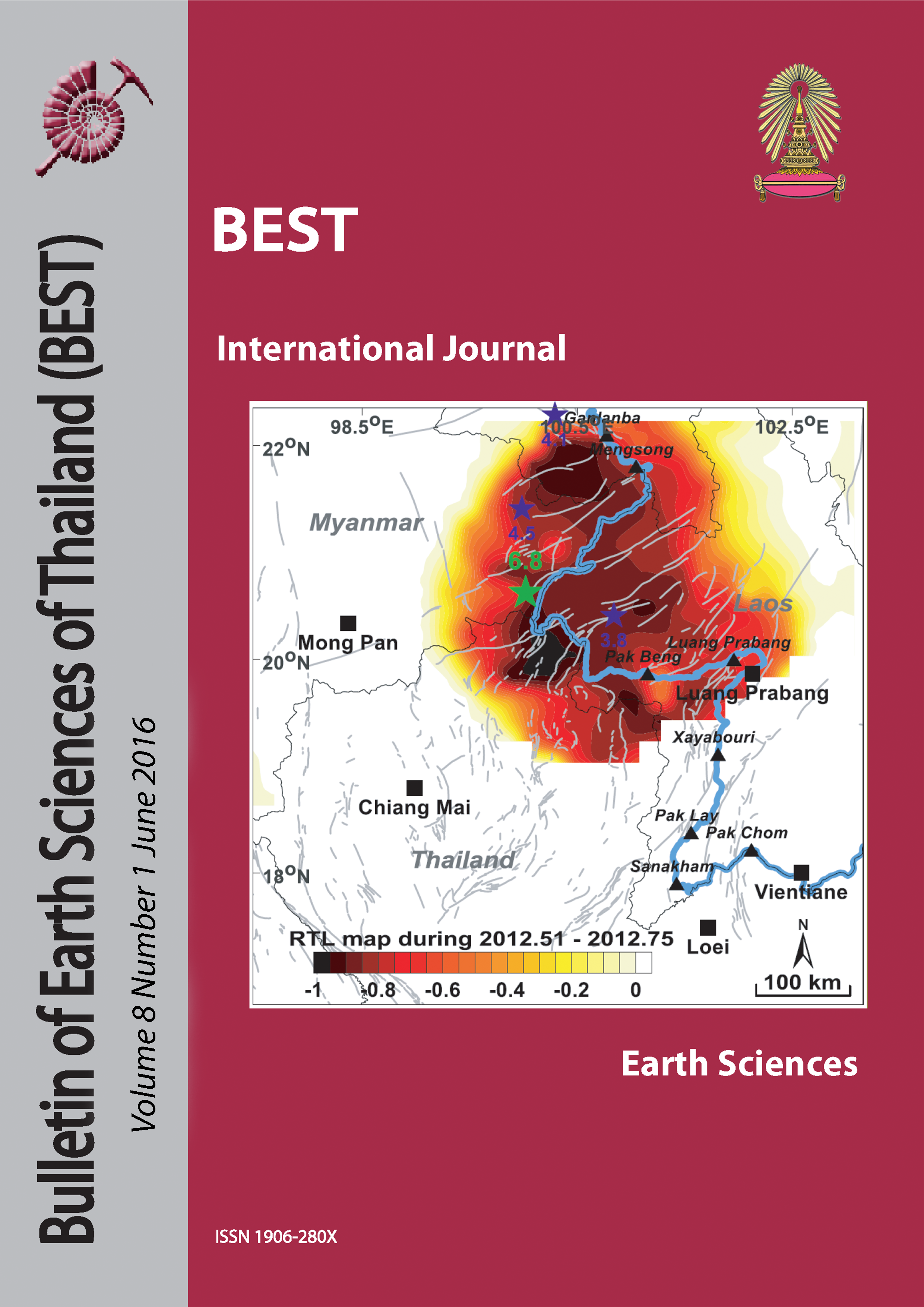Total hydrocarbon profile and trace metal level in sediments from the upper Bonny estuary in southern Nigeria
Main Article Content
Abstract
Sediment cores retrieved from shallow marginal areas at three stations in the New Calabar River Estuary in southern, Nigeria were evaluated for total hydrocarbon content and the level of trace metals between 2011 and 2012. Result of the core profiles of total hydrocarbon content ranged from 0.001 to 130.80 ppm. The observed profiles corresponded with severe environmental perturbations resulting from massive oil spills. The contamination levels of the respective metals varied and the range of mean values are presented in mg/kg along with variations at statistically significant level (P <0.05). In sediment, only Cr varied significantly (p < 0.05) within two years. The constant rate of supply model which was employed to establish the age and date of sediment displayed increase in bulk sediment accumulation over the past 80 years.
Article Details

This work is licensed under a Creative Commons Attribution-NonCommercial-NoDerivatives 4.0 International License.
Copyright © 2008 Department of Geology, Faculty of Science, Chulalongkorn University. Parts of an article can be photocopied or reproduced without prior written permission from the author(s), but due acknowledgments should be stated or cited accordingly.
References
Abam, T. K. S. 1999. Impact of Dams on the Hydrology of the Niger Delta. The Bulletin of Engineering Geology and the Environment. 57(3), 239-251.
Adati, A. K. 2012. Oil Exploration and Spillage in the Niger Delta of Nigeria. Civil and Environmental Research. 2(3), 38 – 51.
Ademoroti, C. M. A. 1996. Standard Methods for Water and Effluent Analysis. Foludex Press. Ltd.. Ibadan, 182pp
Bower, H. J. 1979. Heavy Metals in the Sediment of Foundry Cover. Cold Spring, New York. Environ. Sci. Technol. 13, 683- 687.
Brenner, M. C., Schelske, L., Keenan, L.W. 2001. Historical Rates of Sediment Accumulation and Nutrient Burial in Marshes of the Upper St. Johns River Basin, Florida, USA. J. Paleolimnol. 26, 241–257.
Chindah, A.C., Braide, A.S., Sibeudu, O.C. 2004. Distribution of hydrocarbons and heavy metals in sediment and a crustacean (Penaeusnotialis) from the Bonny River/New Calabar River Estuary, Niger Delta. Afri. J. Envi. Assess. Mgt. 9, 1-17.
Dambo, W. B. 2000. Tolerance of the Periwinkles Pachymelania aurita (Muller) and Tympanotonus fuscatus (Linne) to Refined Oils. J. Environmental Pollution, 79, 293 - 296.
Dublin-Green, C. O. 1985. Some textural characteristics and organic content of recent sediments in the Bonny estuary, Niger Delta. Technical Paper 67 Nigerian Institute of Oceanography and Marine Research, Lagos.
Egborge, A .B. M, Okoro, J. I., Alawani, O. A., Uriah, N. 1986. Thermal and Chemical Pollution of Benin River and its Tributary, the Jamieson River in Nigeria. Nigerian Journal of Applied Science, 4,121-149.
Ekweozor, I. K. E. 1993. An Estuary under Stress: A Case Study of Eighteen Years Chronic Hydrocarbon Pollution of Bonny Estuary, Nigeria. Journal of Nigerian Environmental Society, 2(1), 12-15.
Forstner, U., Wittmann, G. T. W. 1983. Metal pollution in the aquatic environment. Springer-Verlag, Berlin, pp 486.
Idodo-Umeh, G, Oronsaye, J. A. O. 2006. Heavy metal pollution of the sediments from Eriora River in Olomoro town, Niger Delta, Nigeria.Journ. of Sustain. Trop. Agric. Res. 21, 74-
Law, A. T. , Singh, A. 1991. Relationships between Heavy Metal Contents and Body Weight of fish from the Kelang Estuary Malaysia. Marine Pollution Bulletin, 22, 86 - 89.
Matthews, K.M., Kim, C.K., Martin, P. 2007. Determination of 210Po in environmental materials: A review of analytical methodology. Applied Radiation and Isotopes. 65(3), 267–279,
Ndiokwere, C. L. 1984. An Investigation of Heavy Metal Content of Sediment and Algae from the River Niger and Atlantic Coastal Water. Environ. Pollut. (B), 7, 247 – 254.
Nouri, J., Mahvi, A. H., Jahed, G. R., Babaei, A. A. 2008. Regional distribution pattern of groundwater heavy metals resulting from agricultural activities. Environmental Geology, 55(6), 1337-1343.
Nwilo, P. C., Badejo, O. T. 2008. Impacts and management of oil spill in Nigerian coastal environment. Proceedings of the International Conference on the Nigerian State, Oil Industry and the Niger Delta. pp 1217-1232.
Omokheyeke, O., Sikoki, F. D.; Laissaoui, A.; Akpuluma, D., Onyagbodor, P. O.; Benkdad, A., Benmansour, M. 2014. Sediment Geochronology and Spatio-Temporal and Vertical Distributions of Radionuclides In The Upper Bonny Estuary (South Nigeria). Geochronometria 41(4), 369–376.
Onojake, M. C. , Frank, O. 2013. Assessment of heavy metals in a soil contaminated by oil spill: A case study in Nigeria. Chemistry and Ecology, 29 (3), 246 254.
Samarghandi, M. R., Nouri, J., Mesdaghinia, A. R., Mahvi, A. H., Nasseri, S., Vaezi, F. 2007. Efficiency removal of phenol, lead and cadmium by means of UV/TiO2/H2O2 processes. Int. J. Environ. Sci. Tech., 4 (1), 19-25.
Shell Petroleum Development Company (SPDC), 2003. “People and the Environment”.Annual report. The Guardian Newspaper, Oil 50 years on, Tuesday June 13 p16
Tolulope, A. O. 2004. Oil Exploration and Environmental Degradation: the Nigerian Experience.International Information Archives, International Society for Environmental Information Science. EIA04-039, 2: 387-393.
Ukoli, F. A., Taher, K., Egbagbe, E. 2005. Association of Self-reported Consumption of Cooked Meat, Fish, Seafood and Eggs with Prostate Cancer Risk among Nigerians. Infect Agent Cancer, 4, 5- 6.
Twumasi, Y., Merem, E. 2006. GIS and Remote Sensing Applications in the Assessment of Change within a Coastal Environment in the Niger Delta Region of Nigeria. International Journal of Environmental Research and Public Health, 3(1), 98-106.
United Nations Development Programme (UNDP), 2006. “Niger Delta Human Development Report”, pp 74.
Uyigue, E., Agu, M. 2007. Coping with Climate Change and Environmental Degradationin 16 the Niger Delta of Southern Nigeria. Report of community research and development 17 Centre (CREDC), Lagos, Nigeria, 1-31.


